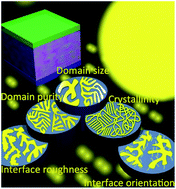Competition between morphological attributes in the thermal annealing and additive processing of polymer solar cells†
Abstract
Thermal

* Corresponding authors
a
Department of Physics, North Carolina State University, Raleigh, North Carolina 27695, USA
E-mail:
harald_ade@ncsu.edu
b
State Key Laboratory of Polymer Physics and Chemistry, Beijing National Laboratory for Molecular Sciences, Institute of Chemistry, Chinese Academy of Sciences, Beijing 100190, China
E-mail:
hjhzlz@iccas.ac.cn
c Graduate University of Chinese Academy of Sciences, Beijing 100049, China
Thermal

 Please wait while we load your content...
Something went wrong. Try again?
Please wait while we load your content...
Something went wrong. Try again?
W. Ma, L. Ye, S. Zhang, J. Hou and H. Ade, J. Mater. Chem. C, 2013, 1, 5023 DOI: 10.1039/C3TC30679H
To request permission to reproduce material from this article, please go to the Copyright Clearance Center request page.
If you are an author contributing to an RSC publication, you do not need to request permission provided correct acknowledgement is given.
If you are the author of this article, you do not need to request permission to reproduce figures and diagrams provided correct acknowledgement is given. If you want to reproduce the whole article in a third-party publication (excluding your thesis/dissertation for which permission is not required) please go to the Copyright Clearance Center request page.
Read more about how to correctly acknowledge RSC content.
 Fetching data from CrossRef.
Fetching data from CrossRef.
This may take some time to load.
Loading related content
